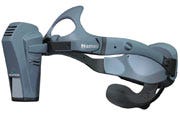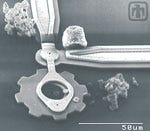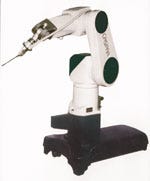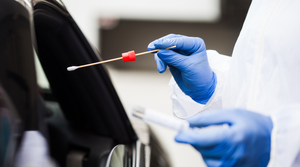Beyond 2001
March 10, 2001
Originally Published MPMN March 2001 Beyond 2001 A survey of some of the emerging technologies that are reshaping the development and manufacture of medical devices Robots share the operating room with surgeons wearing retinal scanning displays. Internet-enabled active implants transmit patient data 24/7 to a network, where physicians and technical personnel remotely monitor device performance and patient status. And the cost of microchips plummets, as conductive plastics and a simplified processing technique enable the use of integrated circuits in a host of new devices. These are just some of the startling developments in store for the medical industry in the years ahead. Read on for a glimpse of the shape of things to come, compiled by the MPMN editorial staff. Nomad shares a vision for the future Retinal scanning displays developed by Microvision (Bothell, WA) may look like something out of M:I-2, but these visors that superimpose images and data on the user's field of vision have applications in the real world. Chris Thero, product manager, explains how the company's Nomad device, currently in beta form, can be used during spinal surgery.
"The surgeon has to place these pedicle screws, and to do so he must look up from the patient at a monitor to see where they should go. Using Nomad, preoperative images can be taken showing where the screws need to be, and these images can be superimposed right on the patient," says Thero. Microvision has developed a technology that sends a computer or video signal into drive electronics that "talk" to the light sources, according to Thero. The beam is scanned on a small mirror that rocks in horizontal and vertical directions and scans the pixels onto a see-through optical viewer. "A beam splitter sends some of that light directly to the user's eye and some to the external world," she explains. "Basically, it gets scanned to the eye without panels or microdisplays. There's no screen, if you will." Beta prototypes currently in use display only monochrome red, but Microvision also has full-color systems in alpha prototype mode. The latter are being tested at Wallace Kettering Neuroscience Institute for use in image-guided surgery. Other applications under serious investigation involve assisting people with low vision. "We have just begun a clinical trial at the Veterans Administration hospital near Stanford University, where we are looking at how Nomad can help people suffering from severe low vision to read," says Richard Duval, medical segment marketing manager. Although Microvision markets its technology in product form to clinics, the company is interested in exploring partnerships with other medical technology companies "where we can augment what they are already offering," notes Duval. "In fact, that is our ideal business model." Plastic microchips may enable new breed of devices Modern plastics may soon replace silicon as the main component of semiconductors, allowing even inexpensive devices to contain microchips. These conductive plastics will significantly lower the costs of integrated circuits by eliminating the expensive process of forging circuits from ultrapure silicon crystals using lithography. While the price of silicon has decreased considerably, even simple silicon devices still sell for around a dollar. State-of-the-art silicon devices cost up to 100 times that much. The oligothiophenes and polythiophenes used to make plastic microchips eliminate many of these cost concerns. Though processing methods are still being developed, these conductive materials will likely be applied in liquid form directly to a substrate using methods similar to silk-screen, ink-jet, or offset printing. Though all of these methods show promise, there are many problems still to be worked out. For example, ink-jet printers currently achieve resolutions of only 25 µm, well shy of the 0.2 µm needed for the most modern circuits. Other challenges include developing a way of applying several types of chemicals simultaneously. When these problems are resolved, scientists see broad technical ramifications for the medical community. In addition to a price reduction in products that already use conventional microchips, it would become cost-effective to incorporate integrated circuits in a range of new devices . Possible products could include bandages with circuits to measure saturation and temperature, or to detect the presence of bacteria. Another application, being developed by Xerox (Stamford, CT), involves the production of large flat-panel digital image sensors. Bob Street, a researcher for the company, says that "printed plastic transistors offer a next-generation technology [necessary] to reduce the costs" of these devices by eliminating the amorphous-silicon transistors currently used. While no one can say when plastic microchips will become a viable technology, Street predicts that image sensors using them will become available within five to 10 years. The Internet links doctors and patients With new technologies like Universal Plug and Play, a networking architecture that can connect PCs, intelligent appliances, and wireless devices, and the Bluetooth standard for wireless technology that allows networking without cables, medical device manufacturers should expect the industry to become Internet-focused in the near future. According to Edward Steinfeld, embedded computing marketing consultant for Automata International Marketing (Westford, MA), "wireless technology, regardless of which technology is used, is a must in current plans for new medical instruments. Every instrument can be networked, and most can have handheld consoles transmitting via radio frequency to the main instrument or to a small server/receiver on a local network." An example of an end-use product that has integrated Internet-based technology is a new wireless device and network that allows doctors to monitor patients hundreds of miles away, and to collect cardiological data. Medtronic (Minneapolis) plans to build a secure network linking patients who have its implanted pacemakers and defibrillators to their doctors and other healthcare services. The company's Chronicle pacemakers and defibrillators will send data to the network that doctors can access. The networking system will include transmitters that can read a patient's heart device remotely, with plans to include portable and wireless devices down the line. Doctors will be able to compile data remotely from electrocardiograms, check how the device is working, and see whether a patient is taking his or her medication. The doctor can then reprogram the device over the Internet or call the patient in for a visit. The amazing world of micromachines A working car the size of a grain of rice. . . .A million microminiature mirrors, fitted on an area the size of a postage stamp. . . .Electric motors narrower than a human hair spinning at 350,000 rpm . . . .These are all examples of the amazing world of micromachines. The medical industry is one of the pioneers mapping this technological frontier.
More than 600 organizations are working on microelectromechanical systems (MEMS), for which the global market is expected to reach $20 billion by 2002. The first widely used MEMS were the simple accelerometers used in automobile airbags. During sudden deceleration, the silicon sensor bends far enough to complete a microcircuit that activates the vehicle's airbag. A similar sensor was developed for disposable blood pressure devices, which greatly reduced costs by replacing a much larger and more expensive instrument. But this simple 2-D microdevice only points the way toward the 3-D MEMS that are being developed for the medical industry. These MEMS often sound like something taken from the film Fantastic Voyage. For example, this technology could enable the development of "smart pills." Powered by tiny motors, smart pills could serve as drug-delivery devices by cruising through a diabetic's bloodstream and automatically releasing insulin when sensing a rise in blood sugar. Using tiny blades, a MEMS device could also be used to cut through arterial plaque or to search for and destroy infected cells. Microfluidic devices, already in use and likely to become popular with pharmaceutical researchers, are like laboratories on a chip. Chemical reactions take place inside the fluid passages that have been micromachined into the devices. The production of such sophisticated MEMS-based devices is one of the biggest hurdles that engineers are trying to overcome. The huge differences in scale between a micromachine's parts and the tooling present enormous obstacles. When parts are being assembled with tiny tweezers, they may either leap away unpredictably or cling to the tweezers due to static electricity. Building a microminiature robot to perform assembly operations may be a solution, but then the question becomes, How do you build the microrobot itself? Engineers have found a solution by creating "factories on chips." Thousands of cilia covering a surface the size of a conventional computer chip can move objects in any direction (up, down, left, right), drop them into specific slots, and even recognize and toss out defective parts. The microminiature factories are still in development, but considering the amazing leaps in technology that we've made in the last decade, engineers may soon be able to turn science fiction fantasies into everyday reality. Robots invade the OR Industrial robots that conform to Class 1 cleanroom requirements are core components of an automated cell that mills patients' femurs to prepare them for the insertion of hip prostheses. Orto Maquet (Rastatt, Germany), a manufacturer of operating tables that has marketed the cell thus far in Germany and France, specified the RX 90 CR robots, developed by Staubli (Horgen, Switzerland), for this application primarily because of their precision and repeatability.
"Maquet claims that the robots drill the bone to an accuracy of 0.1 mm," says Jean-Luc Burquier, group division manager, robotics, at Staubli's production unit in Faverges, France. "A surgeon typically achieves an accuracy of 1 to 2 mm, making a robot 10 to 20 times more accurate than its human counterpart." The machines' extraordinary precision results in less bleeding during the procedure and accelerates rehabilitation, which goes a long way toward allaying any misgivings the patient may have of being operated on by a robot, adds Burquier. The RX 90 robots attracted the attention of Maquet engineers at the mammoth annual manufacturing trade show in Hannover, Germany. "They are made of stainless steel and smooth polyurethane, making them suitable for use in Class 1 environments," notes Burquier. In addition, all of the cables and motors are embedded inside the arm, and the robots have a compact footprint. "We worked with Maquet for a couple of years to adapt the robots to their specifications, and to incorporate additional safety features required by the application," adds Burquier. The first operation using computer-assisted surgical planning and robotics (CASPAR) was conducted in 1997 in Germany. Maquet is currently exploring other applications, adds Burquier, and has achieved two world firsts: the replacement of cruciate knee ligaments in 1999, and the insertion of a tricompartment knee prosthesis. French and German hospitals are using CASPAR, and the cell will soon be installed in hospitals in Belgium and Italy. The company is seeking approval from FDA to market the device in the United States. |
You May Also Like





